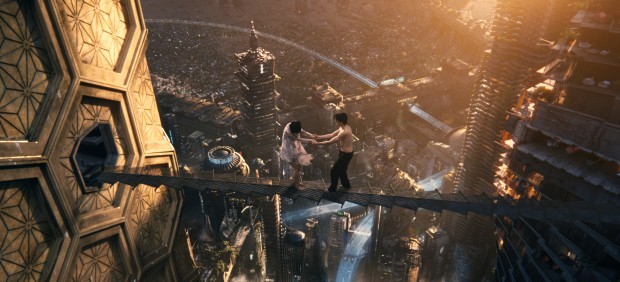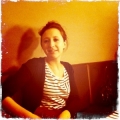You have no items in your cart. Want to get some nice things?
Go shopping
It was never going to be easy. A critically acclaimed novel with a complex Russian doll structure that links characters as far ranging as a nineteenth-century abolitionist and a futuristic clone worker, while playing with concepts as lofty as Nietzsche’s eternal recurrence, Cloud Atlas has long been confined to a dusty box marked “unfilmable: don’t go there”.
Unsurprisingly, then, many greeted the news that David Mitchell’s novel was going to be made into a film with a degree of scepticism. And when it was announced that there would be not one, not two, but three directors working on the film (Andy Wachowski, Lana Wachowski and Tom Tykwer), our scepticism couldn’t help but sharpen. How on earth were three directors going to take 500-plus pages of complex, intricate and unashamedly difficult novel and make sense of it in two-and-a-bit hours’ worth of film?
The answer is, admirably so. Even if it does stumble as often as it soars, Cloud Atlas nonetheless does an incredibly good job of a difficult task, skilfully reshaping the book’s six short stories and interweaving them into an intoxicating film that throbs with energy, sound, colour and – above all – humanity. The film follows concurrently the nineteenth-century story of a young lawyer and a stowaway black slave in the South Pacific, the pre-war tale of a disinherited but ambitious gay musician employed as assistant to an elderly composer, a seventies political thriller featuring a plucky young journalist who exposes the dangerous dealings of a power magnate, and a present-day Kafkaesque farce in which a haphazard and money-short publisher is tricked into self-incarceration in an old people’s home. There is also a jump of 130-odd years to a future dystopia – recognizably sci-fi in its neon lights, genetically modified clones and Blade Runner-esque cityscapes – in Seoul and, further still, to a post-apocalyptic future that sees language reduced to pidgin and white-eyed cannibals stalk a Pacific island. Time is folded, stretched, twanged and knotted into a cat’s cradle that distorts past and present so much that, for a long time, the post-apocalyptic future could be mistaken for a primitive past. Fans of the Wachowski twins and Tykwer might recognize similar tricks from films like The Matrix and Run, Lola, Run, not least these challenges to our perception of conventional time.
Each strand of this multi-threaded story is distinct in genre and form, giving the viewer what could be described as the dubious thrill of romance, crime, comedy, politics and sci-fi all in one go. Each could probab work as a self-contained, satisfying piece of cinema. While some ooze majesty in stunning backdrops and haunting music, others cut through this extravagance with unexpected comedy or intense but unexpressed emotion. But this is not a jumble of disconnected half-films. Scenes leak into one another through carefully opened cracks in time and place, each story is somehow linked, even through the most insignificant of looks, phrases or objects. As viewers, we are charged with finding the echoes, nuances and connections between these six stories, and there is a kind of joyful satisfaction in joining the dots, in following the trail of crumbs: journalist Luisa Rey comes across musician Robert Frobisher’s love letters to Sixsmith; in turn, we glimpse the manuscript of Half-Lives: The First Luisa Rey Mystery on publisher Timothy Cavendish’s desk; hundreds of years later, genetically modified ‘fabricant’ Sonmi will watch the film ‘The Ghastly Ordeal of Timothy Cavendish’; and on and on and on until the last jagged-edged pieces of an elaborate jigsaw puzzle begin to take shape.
And it is not just images and objects that link these stories. One of the aspects of this film that has attracted most criticism is its use of the same actors for multiple roles, especially the use of white actors for Asian characters or vice versa. Hugh Grant, for example, takes a break from playing Mr Bumbling to tackle the roles of cannibal, Korean restaurant manager, immoral nuclear magnate, cuckolded brother and nineteenth-century plantation owner. Half the fun – for all its conceptual musings, this isn’t a po-faced film – is in realizing, hours after leaving the cinema, ‘God, that was Tom Hanks’, or in peering past the prosthetic noses and ageing make-up to see a bearded and one-eyed Hallie Berry. Trying to work out who plays whom, though, was probably not what the three directors intended, and Cloud Atlas does at times teeter rather perilously on the edge of ridiculousness. There may be method in the masked madness, but it isn’t always clear to see. We might look past each character’s get-up – a white-Jewish, blonde Hallie Berry or Hugo Weaving in drag – and through race, time and gender, to the eternally recurring soul beneath, but Cloud Atlas’s stunning visuals are more often than not too ambitious to support the conceptual and emotional needs of this complex narrative.
It is the lack of emotional connection that will bother most viewers. While not devoid of feeling – the fateful relationship between Robert and Sixsmith is heart-wrenching, and there is unbridled joy in the conclusion to Jim Broadbent’s refreshingly farcical tale of escape – the short amount of time lent to each story means that characters and relationships are not as fully realized as they might have been. In the same way, the Wachowskis and Tykwer are only ever able to hint at the concepts and ideas Mitchell’s novel explored in depth. The cuts between scenes happen so quickly that we are often left with a sense of incredible visual dexterity and complexity, but little substance underneath. One of the more experimental aspects of the novel is the dialectal language of the post-apocalyptic Sloosha’s Crossin’ – it might be a minor sticking point, but the mumbled pidgin English in the cinematic version is barely audible and much of the linguistic fun subsequently lost. Similar clumsiness crops up in the over-use of obvious phrases or lingering shots, such as in the scene where Luisa Rey muses that she’s “trying to understand why we keep making the same mistakes over and over”.
If there was ever a film to divide critical opinion, then, this is it. Elaborate, ambitious, ridiculous, beautiful, clever, intricate, delirious, comic, tragic and excessive all at once, Cloud Atlas has reached for the stars and very nearly made it. And there’s something to be said for that.
Cloud Atlas is still showing at selected cinemas across the UK.

About Bella Bosworth
Bella Whittington reads and reviews a bit of everything, but is particularly interested in literary fiction, translations and short stories. After living in Spain for a year, she now works as an assistant editor for Transworld Publishers in London. She has also contributed to Thresholds, the University of Chichester's international short story forum, and the Harker.





Very good review, I agree with so many of your points.
It’s an epic undertaking like no other I have ever seen. The biggest worry was wether the trio of directors could make sense of it all for all kinds of audiences. Honestly, it’s none too hard to fathom the story line or its underlying theme beyond the muddled theology and morality propagate. But from a universal perspective, it’s touching, thought provoking and deeply emotive at times. It’s a long movie, but it was necessary and manages to keep you focused on the continual shifts in story as you connect them past, present and future (pun intended).
So why am I not saying it’s a masterpiece? Well, it’s hard to say. The editing could have been tamed at times and parts connected better which is why I think so many accused it of being a storyline mess. The reality is, it isn’t if you have the ability to recall and revise scenes in your mind, basically the hallmark of thinking! This is not an entertainment movie first, it’s a rare juxtaposed visual and narrative treat. That said, perhaps the multiple collaborators involved in making the film led to what could have been called a masterpiece if a single visionary was at the helm, but in this day and age none exist in epic sci-fi terms. Perhaps Ridley Scott to a degree but Kubrick would have nailed it in all aspects of film making.
This film goes into my top 10 most underrated sci-fi movies of all time which includes films like Moon, A.I and Eternal Sunshine Of The Spotless Mind.
I watched it a couple of days ago and it has satisfied me deeply enough already. I have a question for you. You wouldn’t happen to have watched Cloud Atlas on Tuesday 26th March at Vue Shepherds Bush?
It’s not one of those movies that you watch and it makes you sob all-over-the-place, it’s more of the kind of film that has you interested right off the start, keeps that interest, and delivers pretty well. Not perfect, but still a good way to spend 3 hours watching. Nice review Bella.